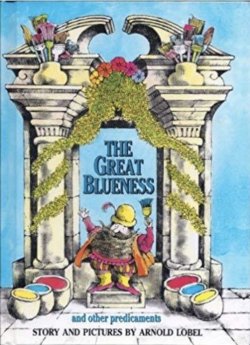Gareth B. Matthews

Review of The Great Blueness and Other Predicaments by Arnold Lobel (New York: Harper and Row, 1968). Originally published in Thinking: The Journal of Philosophy for Children 14(4): 1.
Long ago there was no color in the world – only grey, black, and white. It was the time of The Great Greyness. “Something is wrong with the world,” exclaimed a Wizard. Down in the dark, grey cellar of his house the Wizard mixed up something in a pot and went out with it to paint the thatched roof of his house.
“What is that?” asked the neighbors. “I call it blue,” explained the Wizard.
“Please give us some,” begged the neighbors, and the Wizard did. Soon the whole world was blue. It became the time of The Great Blueness.
Unfortunately, having blueness everywhere made people sad. So, the Wizard went back down into his dark, blue cellar and eventually came out with some thing new, something with which he painted his fence.
“What is that?” asked the neighbors. “I call it yellow,” explained the Wizard.
“Please give us some,” begged the neighbors, and the Wizard did. Soon the whole world was yellow.
Unfortunately, having the whole world gave people headaches. So, the Wizard went back down into his dark, yellow cellar and eventually returned with some thing new. It was something which he painted his flowers.
“What is that?” asked the neighbors. “I call it red,” explained the Wizard.
“Please give us some,” begged the neighbors, and he did. Soon the whole world was red.
Unfortunately, having the whole world red made people angry. So, the Wizard went back down into his dark, red cellar. But this time all he could make was more blue, more yellow, and more red – until the contents of the now overflowing pots began to run together and make purple, green, orange, and brown. The people gleefully took all these colors and soon the world was a many-colored thing. The happy neighbors brought the Wizard red apples, green leaves, yellow bananas, purple grapes, and blue flowers. At last the world was too beautiful ever to be changed again.
This delightful tale, brightly illustrated by the author himself, invites us to reflect on the coloredness of the world – the bright blueness of the sky when the sun comes out after rain, the new greenness of the leaves in spring, and the deep red of a fully ripe strawberry. Sometimes we need a time of Great Greyness to appreciate the vividness of our technicolor world.
Still, there have been plenty of philosophers and scientists who have wanted to tell us that colors are not real. It began with Democritus, the ancient atomist, who thought that only atoms and their shapes and sizes, plus the empty space that separates them, are real. So called secondary qualities, including color, are a sort of dependable illusion, that the wizardry of our minds produces. In reality the world is colorless.
Recently the tables have been turned. If physics can’t explain the emergence of the experience of color, this reasoning goes, then we should conclude that consciousness eludes natural science and so science does not grasp all of reality. So, some philosophers today happily speak of “the mystery of consciousness” and count the wizardry of color perception as a prime component of this mystery.
Earlier in our century problems about understanding the “logic” of statements about color upset the philosophy of logical atomism, a program in philosophy developed by Bertram Russell and Ludwig Wittgenstein. According to this view, all the truths about the world should be reducible to combinations of totally simple truths, such as “This is red” and “That is blue.” But logically simple statements cannot rule out each other, Wittgenstein reasoned; and “This is red” rules out “This is blue,” though it does not rule out “This is maroon.” Wittgenstein concluded that even the simplest color statements he could think of can be shown in this way to have some logical “structure” and so the world cannot be understood to be made up of atomistic facts expressible by logically simple statements.
One-way colors could be said to have structure would be for some colors to be made up of others. But are some colors made up of other colors? Well, we certainly get paint of a different color, as the Wizard found out, by, say, mixing blue paint and yellow paint. Suppose we get green paint. Does that mean that the color green is made up of blue and yellow? Many philosophers have thought not. What do you think?
